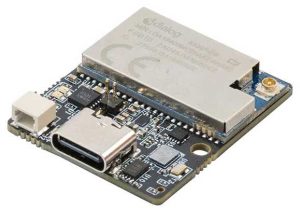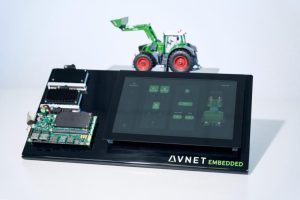By Philip Ling, Senior Technology Writer, Avnet
Is EV charging fully mature?
Let’s start with applications that have reached maturity. It was apparent from the number of demonstrations that more suppliers now see electric vehicle (EV) charging as a key application area. This means they are claiming to offer either a specific and differentiating technology in the vertical supply chain for EV charging, or a full turnkey solution.
This isn’t surprising. The need for EV charging stations, both public and private, is increasing. We are all part of a global countdown to the day when internal combustion engines are no longer sold. When that happens depends on where you are. Avnet has been running a global solutions marketing campaign for EV charging for many months. Every part of our global business has something to offer here, and many of the business units are actively collaborating on bringing more of the total solution to the customer.
Ways to add deeply embedded AI
Artificial intelligence (AI) is a rapidly maturing technology. Putting AI into edge devices has been a hot topic for several years, but it takes time to develop solutions that are production ready. This year there were more than ever on show.
The principle of AI rests on executing an algorithm. That can now be achieved on even the smallest microcontroller. Applications that demand more performance require more resources, and the way those resources are divided between hardware and software is up for grabs.
There were examples of multicore processors designed to do most of the work in software, as well as general purpose microcontrollers and microprocessors with dedicated AI hardware accelerators wired directly into the memory map. Another option is to combine the two approaches into a system-on-chip, and there are examples to prove it. Using FPGAs as the SoC platform is one option, allowing both types of intellectual property to be implemented in the most optimal way for a given application.

The most popular applications for AI, at least by the examples present, are machine vision and voice recognition. Machine vision uses AI to parse the output of an image sensor, much as our brains do. This is one of the most developed applications for machine learning and artificial intelligence, so it’s not surprising that these systems can now achieve certainties in the high 90 percentile for more complex scenes. People detection and gesture recognition are strong differentiators, but defect detection is another valued feature. This involved training a system on objects to identify defective samples. Using AI at the very edge in this way removes system latencies, allowing production lines to operate at higher speeds.
Using AI to detect a wake word before powering up the rest of the system is a great example of how AI is becoming more integrated at the edge. Latency and low power operation are particularly important attributes for always-on edge applications.
The RASynBoard was launched earlier in March and developed by Avnet in collaboration with Renesas, Syntiant, TDK and Edge Impulse. Syntiant contributed the NDP120 Neural Decision Processor, which runs inference engines locally on the company’s Syntiant Core 2 programmable deep learning architecture.
Is Matter ready for mainstream?
Matter, from the Connectivity Standards Alliance, aims to simplify the smart home by enabling all Internet of Things (IoT) devices to interoperate more easily. Leading semiconductor vendors, including Silicon Labs, Infineon, NXP, STMicroelectronics and Nordic Semiconductor, were demonstrating how ready they are to support OEMs developing Matter-enabled IoT devices.
Devices that support and are certified by Matter will typically use multiple wireless protocols. This is an important aspect of the standard, as it removes limitations on the way devices can connect to a home network. The other fundamental feature of Matter is its interoperability between competing smart home infrastructures. You can now buy the same Matter-certified device and connect it to your home network, whoever your provider is. At least, that is the goal.
While great strides have been made toward this goal, it may be a while yet before we start to see large volumes of smart home devices that are certified. And it may also require some new equipment in the home, such as gateways that can communicate with your existing home network and new Matter-certified devices.
What can you do with a micro PLC?

Programmable logic controllers, or PLCs, are the brains behind most industrial processes. These configurable devices have evolved over many decades but remain fundamentally the same. That’s mainly because they need to work in an environment that likes continuity and consistency.
So, what happens when a disruptive technology like open-source hardware turns its attention to the industrial automation sector? The micro PLC happens. There are a growing number of micro PLCs on the market and many of them are based on the Raspberry Pi. The Raspberry Pi Foundation doesn’t specifically supply industrial-grade compute modules for micro PLCs. Instead, innovators take the compute module and toughen it up so it can be used in an industrial environment.
Arduino has taken a different approach with its Pro family. Its Portenta range is designed for industrial applications, and it sits at the heart of the Opta, a micro PLC designed in association with Finder and supplied by Arduino.
The Opta, and other micro PLCs, are aimed squarely at the Industrial IoT. While a micro PLC isn’t as powerful as larger PLCs from larger industrial automation companies, it is clear that the companies behind them see them as a way to bring IoT features into the industrial landscape.
It is defensible to say that established PLC providers have been slow to react to the benefits of the IoT. It will be some time before the industrial automation sector is as comfortable with IoT as, say, the smart home industry. We may never see an industrial-grade version of Matter, for example.
While there are numerous micro PLCs based on the Raspberry Pi compute module, there is currently only one Opta. However, the Portenta board is already qualified for industrial environments, and Arduino is actively building an ecosystem of supporting devices around the Opta for industrial applications. By leveraging its strong community around Arduino, we could see some makers becoming industrial suppliers soon.
New compute modules
Modular-based design is increasing popular and important for OEMs. It offers a common platform with strong ecosystems and short time to market.
COM-HPC is the new standard for high-performance computing on a module. It complements COM Express, rather than replaces it. Module manufacturers are just beginning to hit volume production in this format.
The modules come in two basic variants, client and server. The PICMG standard makes provision for x86, ARM64 and RISC-V processor implementations. For a more comprehensive overview of COM-HPC, take a look at Avnet Embedded’s range of COM-HPC modules, here: COM-HPC – Embedded Compute Modules – Avnet Embedded
At the other end of the performance curve, you will find the Open Standard Module (OSM). Unlike most other modules, the OSM standard from SGeT (Standardization Group for Embedded Technologies) defines modules that are much smaller than most and that support full machine processing. That means the modules are soldered onto a board like a regular component as part of the production process, rather than connected as a mezzanine board or removable compute module, which requires additional and typically manual processing steps.
This standard supports a combination of microcontroller and microprocessor on the same module. The MSC OSM-MF-IMX8NANO from Avnet Embedded is a good example. It is based on the i.MX 8M Nano application processor from NXP, which integrates dual or quad Arm Cortex-A53 cores with an Arm Cortex-M7.
What’s coming soon in embedded electronics?
One of the great things about Embedded World is you get to be present at the birth of new technologies. Embedded World was one of the first places the industry started talking about IoT, long before it became mainstream.
This year, as well as AI, micro PLCs and new module form-factors, there was more evidence of how important open-source hardware will be in the future. This includes the RISC-V instruction set architecture, which is being used in more products now. But it extends to innovative projects like the CORE-V, a RISC-V implementation that targets microcontroller applications.
At a higher level there was some evidence that the use of open-source software will require closer scrutiny in future. The software bill of materials, or SBOM, is a U.S. initiative that requires companies selling products into certain verticals to fully document the software they are using in their product. This allows it to be checked against software distributions with known security vulnerabilities.
While the rest of the world hasn’t adopted an SBOM requirement yet, it could be something the industry needs to deal with soon.








